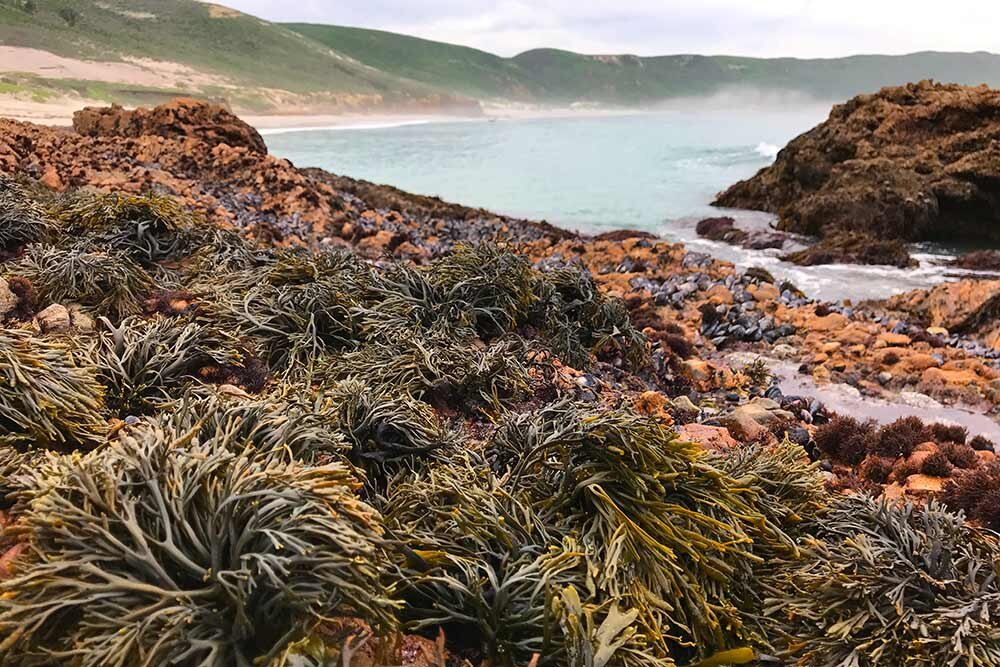Somewhat drab and unassuming, the humble rockweed’s olive-green or yellowish-brown appearance belies its importance in the rocky intertidal zone.
“It’s considered a foundation species,” University of California – Santa Barbara marine scientist Robert Miller said of the seaweed, which anchors to rocks in the zone between high and low tide. The inhabitants of that area must withstand pounding surf, blazing sun, variations in temperatures and tides and drying winds. “Rockweed provides a nice damp habitat that enables other species to survive where they otherwise would get dried out and exposed to the sun and die,” Miller explained.
However, the alga has declined dramatically along the California coast, a phenomenon that has been documented for the last 50 years.
“That decline seems to be due to various factors, including drying out from the Santa Ana winds, trampling by humans during low tides and, potentially, pollution,” Miller said. As a result, the animals that live in and around the alga—from limpets and crabs to barnacles and snails—and the fish that feed in it during high tides lose habitat, which diminishes coastal biodiversity.
Miller and his collaborators are hoping to slow or even reverse that trend with a restoration project that involves transplanting rockweed from places where it is relatively abundant to sparser regions. Funded by the California Ocean Protection Council, he and partners from UCLA, Cal State Pomona and UC Santa Cruz will pinpoint areas up and down the coast that could use a rockweed boost, identify appropriate healthy sites nearby, and transplant the seaweed.
It’s more complicated than just chipping off some healthy rockweed and moving it around, however.”The challenge is that each plant is very used to the spot where it’s growing,” Miller said.
“Unlike many other marine organisms, which broadcast their progeny into the water column to be subsequently transported from their origins via ocean currents, rockweeds release gametes during periods of low water motion,” said UC Santa Barbara doctoral student Stephen Whitaker, whose expertise with their target rockweed species, Silvetia compressa, will inform much of the work involved in this project.
The low water motion and the gametes’ tendency to sink ensure that a high proportion of offspring remain nearby, where their survival is ensured in part by their parents’ canopy cover, Whitaker said. “This short-distance dispersal, as well as adaptive response to the environment, can result in high levels of genetic difference between populations,” he added.
Currently in its earliest, permit-gathering stages, the project will soon involve reconnaissance surveys of potential project areas all along the California coast. These sites include several locations on the northern Channel Islands and the coastal portion of the Dangermond Preserve on the Gaviota Coast.
“One of the elements of our project is to map each donor and recipient site with a drone,” Miller said, “to try to match the tidal height as close as we can when we transplant a plant from one site to another to make sure it’s in a similar habitat.” The unmanned aerial vehicles will be flying at low altitude—roughly 40 meters—to acquire high resolution data and multispectral imaging over large sections of coastline.
In addition to the visual surveys, genetic testing will be conducted by geneticist Paige Miller, with UC Santa Barbara’s Marine Science Institute, to help to ensure that a diversity of rockweed genotypes found in the same region is identified for transplantation. Other measurements of whole rocky intertidal community populations will help to establish a biodiversity baseline prior to planting.
After the transplants, it will be a waiting game to gauge whether and to what extent the restoration of the slow-growing seaweed is successful. Over the next few years the researchers will be monitoring the transplant areas to note how many of the plants survive and propagate, and also to see how the local intertidal rocky community is affected.
“We expect that the rockweed restoration will provide measurable increases in biodiversity,” Whitaker said. Their canopies provide the shading, cooling and sheltering that many rocky intertidal dwellers have come to rely on, including the California mussel, a species declining in abundance, he added.
While many of the factors precipitating the decline of the seaweed still exist, including tidal patterns, trampling (mostly in the case of mainland rockweed), storms, oiling and climate change effects, there is reason to be optimistic: Previous rockweed restorations conducted by the scientists in both southern and northern California have proven successful and yielded best practices for effective restoration.
“Our hope is that restoring some of these populations may bring them back to the point where they can recover,” Miller said. “Not every plant will succeed, but we need to give this species a fighting chance to endure.”
Photo shows Rockweed (Silvetia compressa) at Cuyler Harbor, San Miguel Island. Credit: Stephen Whitaker
This article by Sonia Fernandez at the University of California – Santa Barbara originally appeared on Phys.org. Reprinted here by permission.

